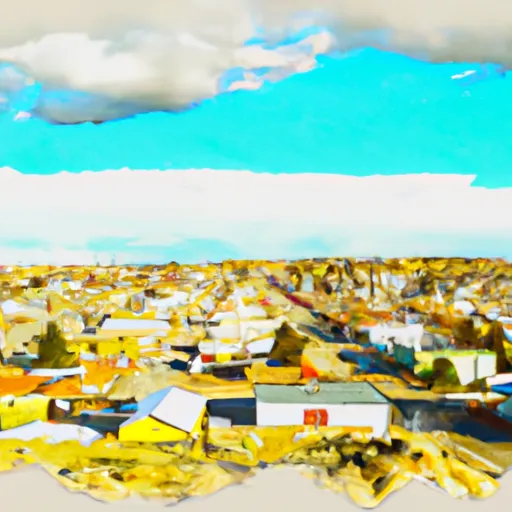-
 Snoflo Premium
Snoflo Premium
Get unlimited access to all our content
With no Ad interruptions! - Start Your Free Trial Login with existing account
Shoshoni
Eden Index
Climate
7.0
•
Recreation
4.0
•
Community
2.3
•
Safeguard
4.8/10

Shoshoni, Wyoming is a small town located in Fremont County. It experiences a semi-arid climate, characterized by hot summers and cold winters. Summers are typically sunny, with temperatures ranging from 70 to 90 degrees Fahrenheit. Winters are cold, with temperatures dropping to the 20s and occasional snowfall.
The town is situated near the Wind River, one of the major hydrological constituents in the region. The river provides opportunities for fishing, especially for trout, and supports a diverse ecosystem.
Shoshoni boasts several outdoor recreation opportunities. The surrounding area is ideal for hiking and camping, with nearby destinations such as the Wind River Mountains offering stunning landscapes and trails for exploration. Adventurers can also enjoy whitewater rafting and kayaking in the area's rivers. Wildlife enthusiasts can spot various species, including elk, deer, and eagles.
Additionally, Shoshoni is known for its hunting opportunities, with game such as antelope and mule deer in abundance during the respective seasons. This small town offers a tranquil and picturesque setting for outdoor enthusiasts seeking to immerse themselves in nature.
What is the Eden Index?
The Snoflo Eden Index serves as a comprehensive rating system for regions, evaluating their desirability through a holistic assessment of climate health, outdoor recreation opportunities, and natural disaster risk, acknowledging the profound impact of these factors on livability and well-being.
Climate Health Indicator (CHI): 7.0
Shoshoni receives approximately
182mm of rain per year,
with humidity levels near 63%
and air temperatures averaging around
8°C.
Shoshoni has a plant hardyness factor of
4, meaning
plants and agriculture in this region thrive during a short period during spring and early summer. Most
plants will die off during the colder winter months.
By considering the ideal temperature range, reliable water supplies, clean air, and stable seasonal rain or snowpacks, the Climate Health Indicator (CHI) underscores the significance of a healthy climate as the foundation for quality living.
A healthy climate is paramount for ensuring a high quality of life and livability in a region, fostering both physical well-being and environmental harmony. This can be characterized by ideal temperatures, reliable access to water supplies, clean air, and consistent seasonal rain or snowpacks.
Weather Forecast
Streamflow Conditions
Big Horn
Area Rivers
Big Horn
Snowpack Depths
Big Horn
Reservoir Storage Capacity
Big Horn
Groundwater Levels
Recreational Opportunity Index (ROI): 4.0
The Recreational Opportunity Index (ROI) recognizes the value of outdoor recreational options, such as parks, hiking trails, camping sites, and fishing spots, while acknowledging that climate plays a pivotal role in ensuring the comfort and consistency of these experiences.
Access to outdoor recreational opportunities, encompassing activities such as parks, hiking, camping, and fishing, is crucial for overall well-being, and the climate plays a pivotal role in enabling and enhancing these experiences, ensuring that individuals can engage in nature-based activities comfortably and consistently.
Camping Areas
| Campground | Campsites | Reservations | Toilets | Showers | Elevation |
|---|---|---|---|---|---|
| Boysen State Park | 280 | 4,889 ft | |||
| Shoshoni City Park | None | 4,841 ft | |||
| Lake Cameahwait - USBR | None | 4,826 ft |
Nearby Fishing
Catastrophe Safeguard Index (CSI):
The Catastrophe Safeguard Index (CSI) recognizes that natural disaster risk, encompassing floods, fires, hurricanes, and tornadoes, can drastically affect safety and the overall appeal of an area.
The level of natural disaster risk in a region significantly affects safety and the overall livability, with climate change amplifying these risks by potentially increasing the frequency and intensity of events like floods, fires, hurricanes, and tornadoes, thereby posing substantial challenges to community resilience and well-being.
Community Resilience Indicator (CRI): 2.3
The Community Resilience Indicator (CRI) recognizes that education, healthcare, and socioeconomics are crucial to the well-being of a region. The CRI acknowledges the profound impact of these elements on residents' overall quality of life. By evaluating educational resources, healthcare accessibility, and economic inclusivity, the index captures the essential aspects that contribute to a thriving community, fostering resident satisfaction, equity, and social cohesion.

